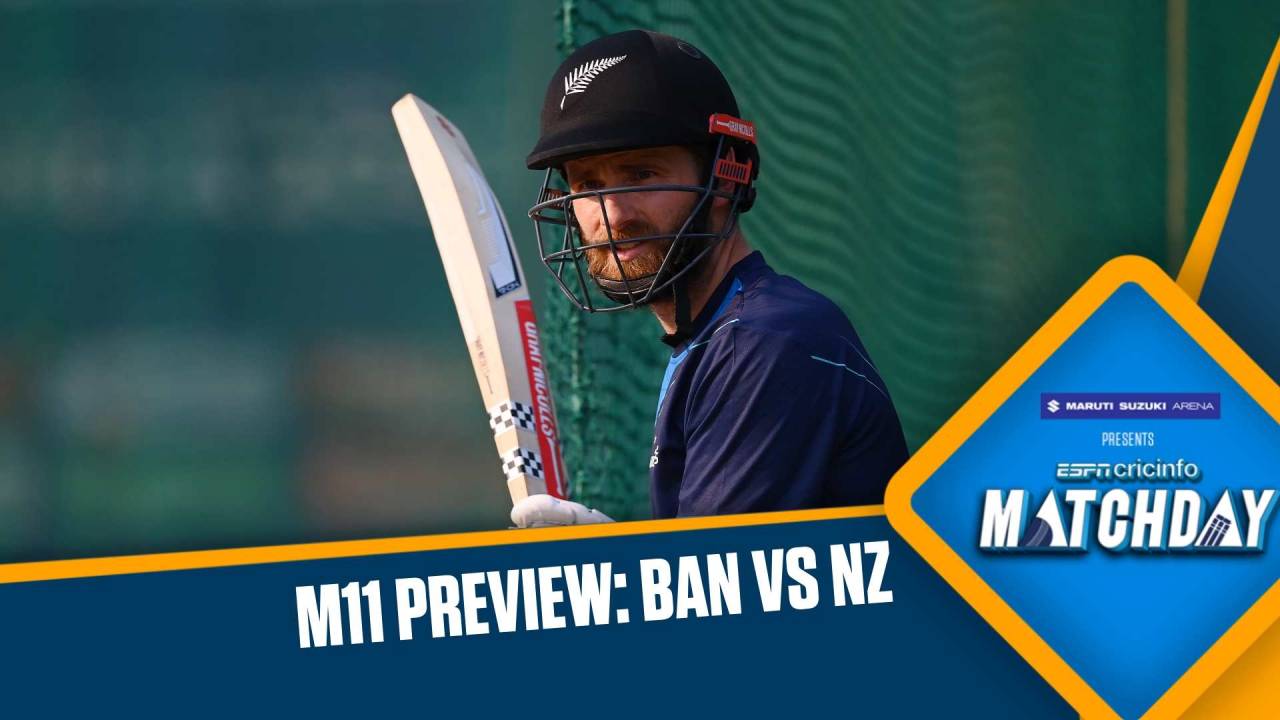And just like that, Williamson is back, bringing the warm glow of the familiar
He's returned from a serious injury with remarkable speed, right at the moment when New Zealand need his skillset most
Karthik Krishnaswamy
12-Oct-2023
The world of 2023 is profoundly different to the world of 2019, but some things have endured. Kane Williamson is one of them. He's the only guy from this photograph to feature in this one.
He's done this against all odds, recovering with remarkable speed from a knee injury that had all but ruled him out of this World Cup, and on Thursday afternoon he brought to Chepauk the warm glow of the familiar.
Here he was, in that knowing way of his, choosing the blandest possible response to every press-conference question. Here he was, in that diffident way of his, making his way to the nets, his head momentarily turned by the noise of a dozen cameras snapping at him in burst mode. Here he was, in that finicky way of his, choosing which ball to force square on tiptoe and which ball - near-identical to the watcher from afar - to dab fine.
Here he was, New Zealand's captain, preparing for his first game of his fourth World Cup.
Much has been made of this tournament showcasing a format going through an existential crisis. At the same time, though, this World Cup also showcases a format that's experiencing a rare period of stability, with no major rule changes taking place between 2019 and 2023. For all of T20's growing influence, Williamson doesn't think ODIs have changed to any great degree in this time.
"Yeah, I think with the number of T20 sort of World Cups that we've had, it's probably meant that there's been a lot more T20 cricket building up to those events," he said. "Yeah, I mean it probably keeps evolving a little bit and there's probably a bunch of things that still remain quite similar that you do need to still keep considering […] We saw in 2019 where there were expectations that there'll be scores of 400-plus where in fact they were probably more [in the] 250 to 260 range, and so there's still a lot of adjustment and adapting to the way you play that gives you the best chance, and I think every team does it a little bit differently."
New Zealand have brought to this World Cup a squad that allows them to bat differently in different conditions, and they'll be thrilled at the timing of Williamson's return. They won their first two games while rattling away at well over a run a ball on flat surfaces in Ahmedabad and Hyderabad, but Chennai promises to be different. It's here, perhaps, that they will most need Williamson's skillset.

Kane Williamson bats at the nets•ICC/Getty Images
No team has made 300 in the last 12 ODIs at Chepauk, and Sunday's World Cup clash between India and Australia was decided by Test-match virtues. India won because they bowled with better control for longer, and because their batters showed greater staying power in tricky conditions.
New Zealand already possess plenty of staying power in Devon Conway, Daryl Mitchell and Tom Latham - all proven Test batters - but in conditions that are likely to bring spin into play, and against a Bangladesh attack made for those conditions, they'll gladly welcome more of it.
You don't need reminding of all the times Williamson's staying power has won New Zealand World Cup games, but here's a recap anyway. Auckland, where Mitchell Starc looked all but unstoppable. Birmingham, where Williamson masterminded a seesawing chase of 242. Manchester, where he turned 7 for 2 into a total of 291. Manchester, again, where he scrapped away in seaming conditions to give New Zealand a total they could bowl at.
For every ODI that looks like an extended T20 slugfest, there's one that ebbs and flows like a condensed Test match. These tend to occur quite often at World Cups, for a number of reasons. They feature a number of matches on used pitches, for one. Perhaps more crucially, teams bring their best attacks to these tournaments, having spent much of the build-up resting key bowlers and testing out new faces.
It's against the best attacks and in less-than-ideal conditions that the best batters stand out from the crowd.
This is why teams won't worry too much about their linchpins even if they've not scored too many runs in the lead-up to the tournament. Joe Root scored one fifty and made seven scores of 11 or less in his last nine ODI innings before this World Cup, but it was no surprise to anyone that he began the tournament with back-to-back scores of 77 and 82. Williamson, dogged by injury, has played only 12 ODIs since the 2019 World Cup, scored his runs at a strike rate of 70.33 - well below his career figure of 80.97 - and hasn't featured in the format since January.
It's likely, though, that none of this will matter on Friday. There's every chance, instead, that Williamson will mark his guard, waggle his bat behind him in that twitchy way of his, and flow into his drives like 2019 never went away.
Karthik Krishnaswamy is an assistant editor at ESPNcricinfo
